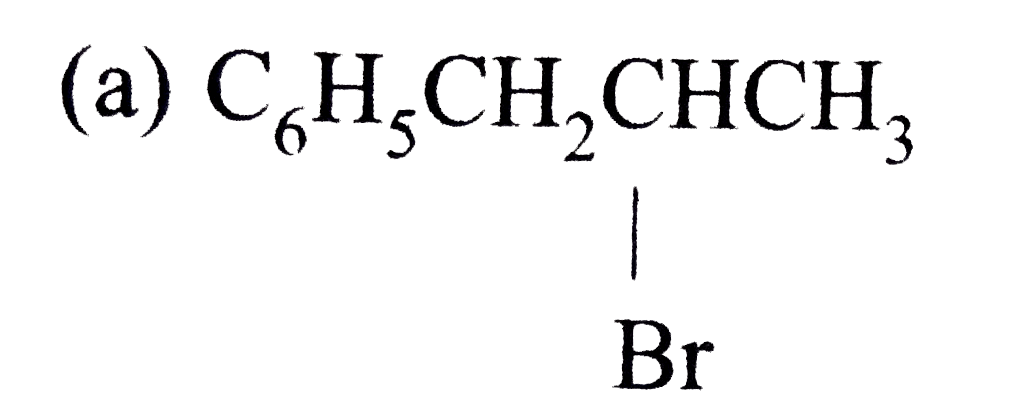The product of the reaction of Ph2CHCh2OH with HBr is
Ph2C=CH2
PhCH∣PhCH2Br
PhCHBrCH2Ph
PhCH=CHPh
The correct Answer is:C
To determine the product of the reaction of diphenylmethanol (Ph₂CHCH₂OH) with HBr, we can follow these steps:
1. Identify the Reactants:
The reactant is diphenylmethanol, which can be represented as Ph₂CHCH₂OH. Here, "Ph" stands for the phenyl group (C₆H₅).
2. Protonation of the Alcohol:
When HBr is added, the hydroxyl group (-OH) of the alcohol will be protonated by the H⁺ from HBr. This step converts the -OH group into a better leaving group (water, H₂O).
Ph2CHCH2OH+H+→Ph2CHCH2OH+2
3. Formation of Carbocation:
The protonated alcohol (Ph₂CHCH₂OH₂⁺) will lose a water molecule (H₂O), leading to the formation of a carbocation. The carbocation formed is initially a primary carbocation, which is not very stable.
Ph2CHCH+2+H2O
4. Carbocation Rearrangement:
To stabilize the carbocation, a phenyl group can shift from the adjacent carbon to the carbocation center, forming a more stable tertiary carbocation. This is known as a phenyl shift.
Ph2C+CH2Ph
5. Nucleophilic Attack by Bromide Ion:
The bromide ion (Br⁻) from HBr will then attack the carbocation, resulting in the formation of the final product.
Ph2CBrCH2Ph
6. Final Product:
The final product of the reaction is diphenylbromomethane (Ph₂CBrCH₂).
Conclusion:
The product of the reaction of diphenylmethanol (Ph₂CHCH₂OH) with HBr is diphenylbromomethane (Ph₂CBrCH₂).
The reactant is diphenylmethanol, which can be represented as Ph₂CHCH₂OH. Here, "Ph" stands for the phenyl group (C₆H₅).
When HBr is added, the hydroxyl group (-OH) of the alcohol will be protonated by the H⁺ from HBr. This step converts the -OH group into a better leaving group (water, H₂O).
Ph2CHCH2OH+H+→Ph2CHCH2OH+2
The protonated alcohol (Ph₂CHCH₂OH₂⁺) will lose a water molecule (H₂O), leading to the formation of a carbocation. The carbocation formed is initially a primary carbocation, which is not very stable.
Ph2CHCH+2+H2O
To stabilize the carbocation, a phenyl group can shift from the adjacent carbon to the carbocation center, forming a more stable tertiary carbocation. This is known as a phenyl shift.
Ph2C+CH2Ph
The bromide ion (Br⁻) from HBr will then attack the carbocation, resulting in the formation of the final product.
Ph2CBrCH2Ph
The final product of the reaction is diphenylbromomethane (Ph₂CBrCH₂).
The product of the reaction of diphenylmethanol (Ph₂CHCH₂OH) with HBr is diphenylbromomethane (Ph₂CBrCH₂).
Topper's Solved these Questions
- ALCOHOL, PHENOL AND ETHERSBOOK - R SHARMACHAPTER - ALCOHOL, PHENOL AND ETHERSEXERCISE - Follow -Up Test -7
10 Videos
- ALCOHOL, PHENOL AND ETHERSBOOK - R SHARMACHAPTER - ALCOHOL, PHENOL AND ETHERSEXERCISE - Follow -Up Test -8
8 Videos
- ALCOHOL, PHENOL AND ETHERSBOOK - R SHARMACHAPTER - ALCOHOL, PHENOL AND ETHERSEXERCISE - Follow -Up Test -5
14 Videos
- AMINESBOOK - R SHARMACHAPTER - AMINESEXERCISE - Archives
36 Videos
Similar Questions
Knowledge Check
The reaction of C6H5CH=CHCH3 with HBr produces
AC6H5CH2CH2CH2BrB CC6H5C∣BrHCH2CH3DC6H5CH2C∣BrHCH3
CC6H5C∣BrHCH2CH3DC6H5CH2C∣BrHCH3The reaction of C6H5CH=CHCH3 with HBr produces
AC6H5CH2CH2CH2BrB CC6H5C∣BrHCH2CH3DC6H5CH2C∣BrHCH3.
CC6H5C∣BrHCH2CH3DC6H5CH2C∣BrHCH3.The reaction of C6H50CH=CHCH3 with HBr produces
A BC6H5CH2CH2CH2BrC
BC6H5CH2CH2CH2BrC D
D
The product of the following reaction:
CH2=Ch−CCl3+HBr→is ________.
View SolutionThe reaction of C6H5CH=CHCH3 with HBr produces
View SolutionThe reaction of C6H5CH=CHCH3 with HBr produces
View SolutionThe final product obtained in the reaction :
CH2=CHCH2CH2CO2HBr2/OH⊕−−−−−−→
View SolutionThe reaction of C6H5CH=CHCH3 with HBr produces
View Solution
